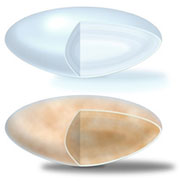Cataracts are the most common cause of vision loss in people over age 60 and is the principal cause of blindness in the world. In fact, there are more cases of cataracts worldwide than there are of glaucoma, macular degeneration and diabetic retinopathy combined, according to Prevent Blindness America (PBA).
Today, cataracts affect more than 22 million Americans age 40 and older. And as the U.S. population ages, more than 30 million Americans are expected to have cataracts by the year 2020, PBA says. Contrary to what most people may think, cataract surgery is a quick, painless outpatient procedure. Cataract surgery can change a person’s outlook on life.
Cataract Signs and Symptoms
A cataract starts out small and at first has little effect on your vision. You may notice that your vision is blurred a little, like looking through a cloudy piece of glass or viewing an impressionist painting.

Clear vs. Cloudy Lens
Hazy or blurred vision may mean you have a cataract. A cataract may make light from the sun or a lamp seem too bright or glaring. Or you may notice when you drive at night that the oncoming headlights cause more glare than before. Colors may not appear as bright as they once did.

Distorted Vision
The type of cataract you have will affect exactly which symptoms you experience and how soon they will occur. When a nuclear cataract first develops, it can bring about a temporary improvement in your near vision, called “second sight.”
Unfortunately, the improved vision is short-lived and will disappear as the cataract worsens. On the other hand, a subcapsular cataract may not produce any symptoms until it’s well-developed. The lens inside the eye works much like a camera lens, focusing light onto the retina. It adjusts the eye’s focus, letting us see things clearly both up close and far away. The lens is mostly made of water and protein. The protein is arranged in a precise way that keeps the lens clear and lets light pass through it. But as we age, some of the protein may clump together and start to cloud a small area of the lens. This is a cataract, and over time, it may grow larger and cloud more of the lens, making it harder to see.

Blurring or Dimming Vision
No one knows for sure why the eyes lens changes as we age, forming cataracts.
Researchers are gradually identifying factors that may cause cataracts — and information that may help to prevent them. Many studies suggest that exposure to ultraviolet light is associated with cataract development, so eye care practitioners recommend wearing sunglasses and a wide-brimmed hat to reduce your exposure. Other types of radiation may also be causes. For example, a 2005 study conducted in Iceland suggests that airline pilots have a higher risk of developing nuclear cataract than non-pilots and that the cause may be exposure to cosmic radiation. Other studies suggest people with diabetes are at risk for developing a cataract.

Normal vs Yellowed Vision
Some eye care practitioners believe that a diet high in antioxidants, such as beta-carotene (vitamin A), selenium and vitamins C and E, may forestall cataract development.
Lauderdale Eye Specialists provides this on-line information for educational purposes only and it should not be construed as personal medical advice. Lauderdale Eye Specialists disclaims any & all liability for injury or other damages that could result from use of the information obtained from this site.


